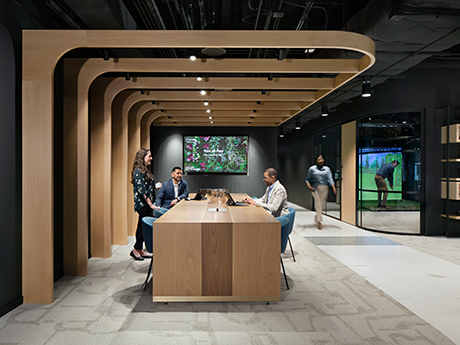By Ben Azulay, Bradford Allen
As summer approaches, I’m noticing Chicago’s downtown buzzing with renewed energy, and new signs that the Loop’s office market is heating up as well. In fact, research by my firm, Bradford Allen, suggests a Chicago office market nearing its bottom and poised for recovery.
Improved leasing activity, strategic landlord adaptations and discounted sales are reshaping downtown Chicago’s market, particularly in high-demand submarkets like the West Loop and Fulton Market.

Client certainty
Office tenants in downtown Chicago are demonstrating increased confidence about their space needs, as reflected in significant expansion deals and long-term commitments. In fact, office expansions drove at least five of the 10 largest leases signed during the first quarter, including Stripe more than doubling its footprint at 350 N. Orleans from 45,000 to 89,000 square feet and Blue Owl’s second expansion at 150 N. Riverside from 27,000 square feet to 54,000 square feet.
Large new leases included BP renewing 240,000 square feet at the CME Center, and Goldman Ismail signing a 43,000-square-foot deal at 191 N. Wacker. Leasing volume totaled 1.7 million square feet, up from 1.3 million square feet year-over-year, with the West Loop alone securing 916,760 square feet of leasing activity.
Compared to even a year ago, much less during the depths of the pandemic, I’m hearing from more clients who are resolute while searching for their space needs, instead of hedging on their futures.
Rise of spec suites
Building out speculative office suites is becoming an increasingly good bet for landlords willing to take a risk and invest in their properties upfront to make them more attractive to tenants. Spec suites in downtown Chicago accounted for 38.9 percent of leasing activity in the first quarter, up from 26.6 percent in fourth-quarter 2024.
The rising popularity of spec suites aligns with shifting tenant preferences for turnkey, move-in-ready options as companies prioritize speed over long-term build-outs. Landlords with the financial wherewithal are making a strategic response to tenant needs with these build-outs, which cater to smaller tenants and fuel faster occupancy.
Class A continues to win
Demand for top-tier office spaces continues to drive Chicago’s office market, with tenants finding they’ll be most successful with return-to-office pushes if they gravitate toward premium spaces in prime locations with modern amenities. Class A assets absorbed 111,230 square feet in the first quarter, versus Class B and C properties that are still experiencing negative absorption.
Meanwhile, trophy buildings like Salesforce Tower and Willis Tower secured major refinancing packages: $610 million and $1.3 billion, respectively, showing lender confidence in high-performing assets. Class A buildings in submarkets like the West Loop and Fulton Market posted the strongest performance: The West Loop alone absorbed 316,000 square feet of Class A space, while Fulton Market saw all its positive absorption from Class A assets, underscoring their dominance in tenant demand.
This is reflected in vacancy numbers as well. The direct vacancy rate for Class A office space across downtown Chicago averaged 20.6 percent in the first quarter. While still stubbornly high, that nearly 21 percent vacancy rate is still much healthier than the approximately 28 percent direct vacancy rate for Class B space and 24 percent rate for Class C space in Chicago’s central business district.
In the best performing submarkets such as Fulton Market and the West Loop, Class A space is beginning to show signs of scarcity, with vacancy rates averaging between 15 to 17 percent at the beginning of the year.
Investors seize opportunities
Perhaps the most bullish sign for Chicago’s office market is rebounding investor interest driven by deeply discounted valuations and opportunities for repositioning assets. Office sales volume reached $156.7 million at the end of the first quarter, more than double the $72.3 million recorded in the first quarter of 2024.
The best example during this period was 3Edgewood’s $88.7 million acquisition of Groupon’s former headquarters at 600 W. Chicago Ave. While the sale was an 83 percent cut from the property’s previous sales price, it was also the largest office sale in downtown Chicago since 2022.
More office conversion projects are also gaining traction with developers. Two major initiatives, including one at the landmark 38-story Pittsfield Building near Millennium Park, will take more than 130,000 square feet of office space off the market and convert it into 300 residential units. At least 11 such conversions are now in the pipeline in downtown Chicago, reflecting investor confidence in downtown Chicago as not only a hub for office workers, but also a vibrant residential and retail destination.
Looking ahead
Between new tenant expansions, the continued popularity of spec suites, renewed interest in Class A properties and renewed investor activity, I believe Chicago’s downtown office market is finding its footing and reaching a turning point. While challenges such as elevated vacancy rates persist, the trends we’re noticing suggest a path toward recovery.
As landlords adapt to tenant needs and investors capitalize on corrected valuations, Chicago’s office market is poised for a broader resurgence. The growing residential presence downtown will further catalyze economic activity, including more demand for office, retail and hospitality spaces. While Chicago has stomached its fair share of challenges since the pandemic, it’s also beginning to show its enduring potential as a dynamic and resilient downtown.
Ben Azulay is president of realty services with Bradford Allen. This article originally appeared in the June 2025 issue of Heartland Real Estate Business magazine.


